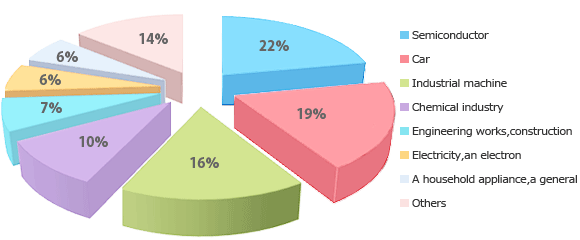What is fluorocarbon resin?


Fluorine is also called PTFE which is from the first letters of its' technical name PolyTetraFluoroEthylene.
In 1938, PTFE was discovered by Dr. Roy J. Plunkett who was a research chemist at US DuPont when he was conducting tetrafluoroethylen (TFE) gas experiment. At this experiment, TFE was stored in a cylinder and gas should have come out of the cylinder, however, none of gas came out. Dr. Plunkett opened the cylinder and he found a white powder there. The white powder he found was PTFE.
Fluorite is a colorful stone and shines beautifully. When fluorite acts on acid, their chemical reaction creates fluoric acids. And when fluoric acids act on chloroform, their chemical reaction creates a substance. Once the substance is pyrolytically decomposed, raw material of PTFE is made. Fluorocarbon resin has features of heat resistance, chemical resistance, electrical insulation, non-adhesive and low friction. These features make fluorocarbon resin be useful to varieties of fields and environment.
Mostly fluorocarbon resin is used for industrial use, however, we are able to find products which are made with fluorocarbon resin in our daily life such as dome shaped roof (Tokyo dome is one example.), coated frying pans and rice cookers and so one.
Feature of fluorine

Usage of fluorinecarbon resin

| Semiconductor | Often used at components that get in contact with chemicals. |
|---|---|
| Automobile | Automobile Used at hydraulic seal ring, accelerator cable, trench opener cable components. |
| Industrial machine | Frequently used at sliding components. |
| Chemical industry | Used at lining parts for gasket and packing components. |
| Engineering works and construction | Used at corrosion prevention, weatherproof topcoat, protective coating components. |
| Electricity | Used at several kinds of coated cables |
| Household appliances | Used at each roller component s or sliding parts. |
Precautions concerning PTFE products
- There is no particular problem as long as it is handled at operating temperature of 260℃ or lower.
- Even if it comes in contact with food products, there is no problem as it meets the standards of the Food Safety and Health Law.
- The fluorocarbon resin is a safe non-active substance.
- When disposing, please do as according to "Waste Disposal and Cleaning Law" and never incinerate.
Heat decomposition
- If the resin is heated to a temperature higher than 260℃ harmful decomposition occurs as regular plastics.
- If the operating temperature may exceed the temperature mentioned above, enough ventilation is needed.
- When handling the fluorocarbon resin at high temperature, air exhaust system and air supply masks must be used.







